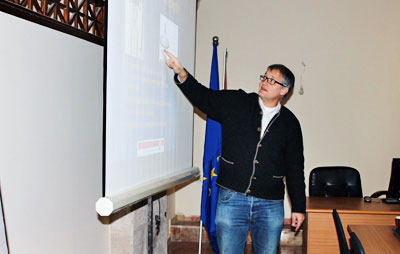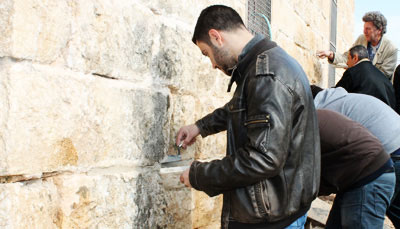A Core Course on (The Conservation and Management of the Built Heritage in Jerusalem) was held between 17.11.2013 and 15.01.2014 in the Old City of Jerusalem.
Seven international and five local experts participated in the training of various subjects within the course. The course was attended by 14 trainees. The theoretical section of the course included the following topics:
• Introduction to the principles of architectural preservation, documentation and registration and information management.
• Techniques and materials used in historic buildings in terms of: characteristics, scientific investigations and assessment of the condition of the buildings.
• Introduction to historical development in the Old City of Jerusalem.
• Documenting and recording architectural heritage.
• Introduction to the structural analysis of historic buildings and assessment of the structural behavior of these buildings .
• Site management planning and management of architectural conservation projects and maintenance programs.

The Course also offered practical training in the field of conservation based on the EU funded restoration projects, along with a field trip to several sites offering models of Roman architecture (Caesarea and the water channel there), Umayyad architecture (the White Mosque in the city of Ramla and its ruins), Abbasid Architecture (the Abbasid Water Tank in Ramla), Frankish Architecture (al-Jami’ mosque and the church of Saint Gregory in the city of Lod) and Mamluk architecture (the bridge built by - Zahir Baybars at the entrance of the city of Lod in the town of Jindas, the Ramle City Tower, the shrine of the prophet’s companion, Abu Huraira in the town of Ebtany near Ashdod , the minaret of Prince Bashtak in Linyi, the Tower built by al-Nasir Muhammad bin Qalawoun in Ramle, the Hilu Khan in Lod , the Khan in the town of Geljoulieh and the shrine of the mullah Ali bin al-'Alim, in the town of al-Haram near Herzliya).

At the end of the course, trainees were divided into groups to work on a selected case study and their work was presented in a report which was reviewed by a Technical Jury for evaluation and assessments.
This course is part of the efforts to establish an applied training institute for practitioners and professionals in the preservation of architectural heritage , and offer capacity building and applied training for engineers, architects, contractors and skilled labour involved in conservation.